Snowshoe Cat
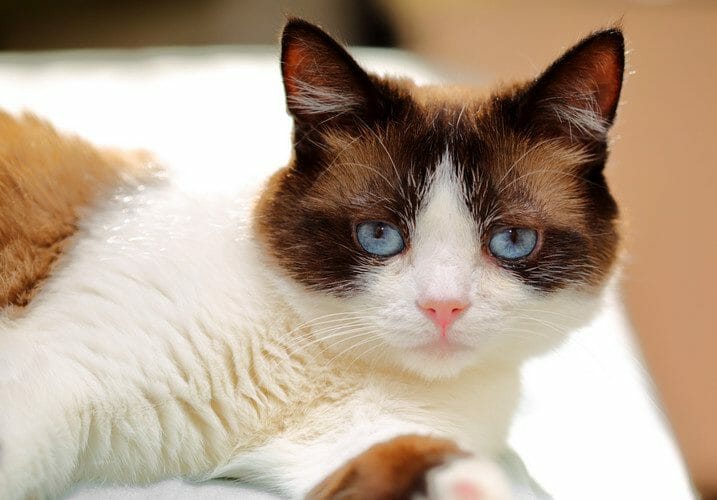
Snowshoe Cat Breed
Originating in the United States, the Snowshoe cat is a rare breed that is descended from the Siamese and the American Shorthair. Just like the Siamese, Snowshoe cats are pointed. This means that they have light bodies with dark patches in seal or blue on the ears, legs, and tail, and a mask surrounding their eyes. Their bodies are rounder than their Siamese ancestors and their coat is short.
One of the most notable features of the Snowshoe is the distinctive white paws at the end of their darker legs. These are called “mittens” on the front, and “boots” on the back paws.
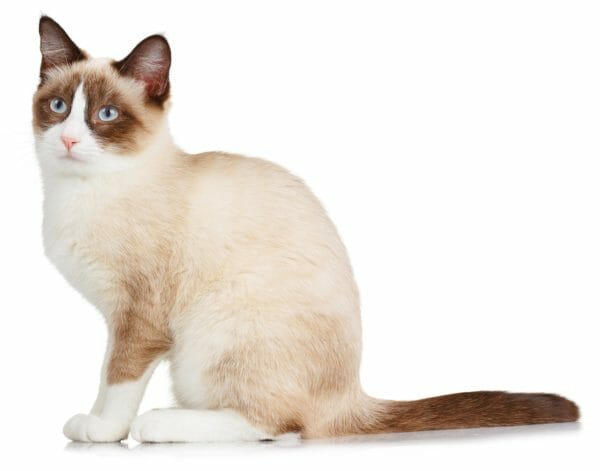
What Does a Snowshoe Cat Look Like?
Snowshoe cats take the classic features of the Siamese and American Shorthair breeds. With the body length of the Siamese and the mass of the American Shorthair, this medium-large feline has a moderate build.
Heads will be either apple-shaped or triangular, and these felines often have markings on the face. An upside down “V” marking is standard for the Snowshoe. They have wide, pointed ears and blue, walnut-shaped eyes. The fur of the Snowshoe is single-coated and pointed.
Snowshoe Cat Colors
The Snowshoe cat comes in a variety of colors:
- Chocolate
- Blue
- Fawn
- Orange
- Black
- Lilac
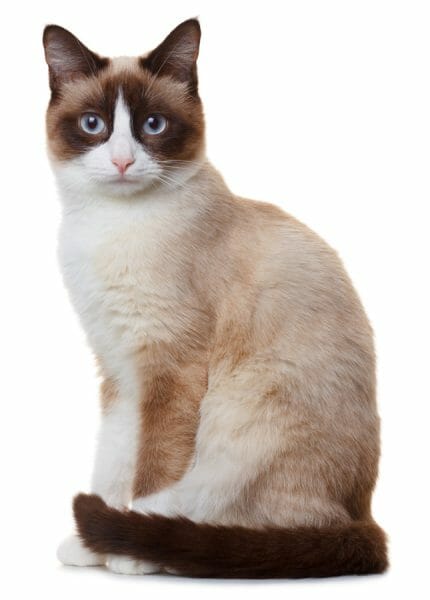
Snowshoe Cat Size
A medium-large-sized cat, the male Snowshoe weighs between 9 and 12 pounds. A female may be as large physically. However, they will typically weigh between 7 and 10 pounds.
Snowshoe Cat Personality
The chatty Snowshoe is less demanding than its Siamese ancestor. Able to form a good connection with the humans it lives with, these cats are effective communicators and will always let their owners know what they want.
Curious and inquisitive, this mischievous and playful feline can often be found getting itself into trouble. Unlike many other breeds, the Snowshoe likes water and is known to enjoy swimming. This friendly and entertaining cat makes a wonderful companion pet, even for a first-time owner.
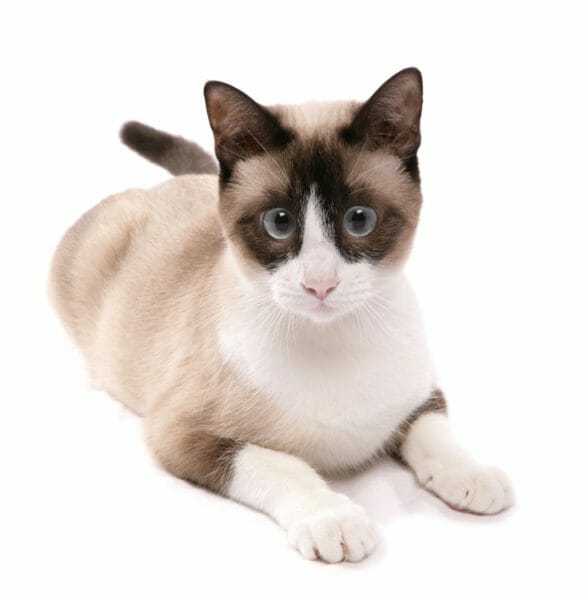
History of the Snowshoe Cat
Early Snowshoe cats date back as far as the late 19th century. Photographs from the era depict Siamese kittens that have four white paws. However, it would be several decades before the breed in its modern form would be developed.
The first white-pawed Siamese cats briefly appeared in the 1950s. In the 1960s, a Siamese breeder called Dorothy Hinds-Daugherty bred a litter of kittens in Philadelphia, Pennsylvania. Out of this litter, three cats had white feet and points. She then began trying to emulate this look in further kittens by breeding a seal point Siamese with a bicolor American Shorthair.
The kittens produced did not have the Siamese points. However, they were then bred with Siamese cats, and the white-footed look was achieved. Due to their appearance, Hinds-Daugherty called the breed “Snowshoe.”
The Snowshoe was shown at local cat shows. However, as the breed was not formally recognized, Hinds-Daugherty stopped breeding them. Fortunately, this task was taken up by Vikki Olander, who wrote the first breed standard and managed to get the cats recognized as an “experimental breed” by the American Cat Association (ACA) and Cat Fanciers Federation (CFF) in 1974.
By the late 1970s, Olander was the only Snowshoe breeder in the United States. Eventually, she was contacted by Jim Hoffman and Georgia Kuhnell—both of whom were interested in growing the breed. Working together, they were able to obtain CFF champion status. Olander stopped breeding Snowshoes in 1989 because of her partner’s cat allergy.
The American Cat Fanciers Association granted the breed championship status in 1990, and The International Cat Association formally recognized it in 1993. The breed is also recognized by the Cat Fanciers Federation and the Fédération Internationale Féline.
To this day, the breed has yet to be accepted by the Cat Fanciers Association. This is because there are currently insufficient breeders and too few Snowshoes in existence.
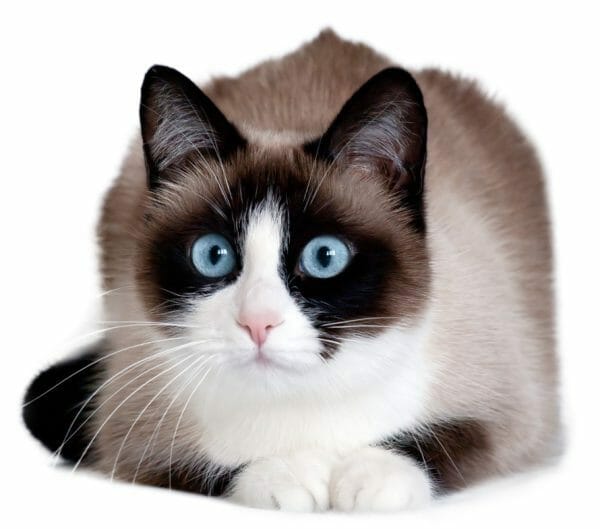
Snowshoe Cat Health Problems
Overall, the Snowshoe is a hardy breed that has very few genetic health concerns. Although rare, the genetic problems affecting Snowshoes include Polycystic Kidney Disease (PKD) and Hypertrophic Cardiomyopathy (HCM). Understanding the signs and symptoms of these conditions will help ensure early diagnosis and treatment can be sought.
- Polycystic Kidney Disease (PKD). An inherited condition that causes pockets of fluids to form on the kidneys, PKD will gradually worsen over time leading to renal failure. To diagnose PKD, a veterinarian will analyze blood and urine samples. There is no specific treatment. However, fluid therapy, medication, and a change in diet may be prescribed to reduce the symptoms.
- Hypertrophic Cardiomyopathy (HCM). HCM is the most common form of heart disease in cats. It causes the muscular walls of the heart to become rigid, making it harder to pump oxygenated blood around the body. Many cats do not display symptoms of HCM. However, those that do may be lethargic and appear to have breathing difficulties. Veterinarians will use echocardiography to diagnose HCM. Treatment is centered around managing the heart rate and alleviating lung congestion. The prognosis for HCM varies. Some cats can live a long life with very few problems. For others, the condition may get progressively worse and lead to the development of congestive heart failure and blood clots. This is because ineffective pumping may cause blood to build up in the other chambers of the heart or in the lungs.
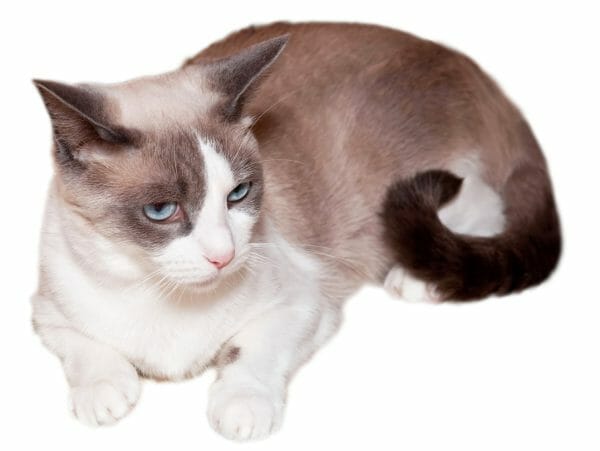
Snowshoe Cat Lifespan
With the right environment, diet, and activity levels, a Snowshoe can expect to live for between 14 and 19 years. Owners should ensure their cat is given regular vaccinations in line with the veterinarian’s recommended schedule.
Ticks, fleas, and other parasites (such as tapeworm, ringworm, and heartworm) can cause health issues. To minimize the risks associated with parasites like these, felines should receive monthly preventative treatments.
Snowshoe Cat Adoption
Before looking for a Snowshoe cat breeder, potential owners should always explore the option to adopt. Every year, many cats are given up for adoption and need a new home. Always adopt from a no-kill shelter. Centers like these have strict guidelines that ensure they do not put down healthy cats.



